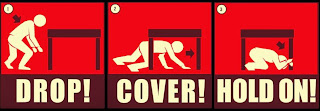This week we are exploring earthquakes and what countries do to prevent/mitigate the hazard. If I want to know something about earthquakes in a place,
the first websites I go to are: the USGS Real Time Earthquakes
Website or the IRIS monitoring website.
Re: where quakes are located in the US, the 2014 US map of
seismicity (see image below from USGS) shows the (obvious, in pink) ring of fire
portion on the West coast but also a central area in the middle of the plate.
I’d like to talk a bit more about this non-obvious one. This area, called
the New MadridZone was shaken by a M8(!) in 1811.
The reason for the activity is a very old intraplate rift placed below the area
(see image from http://showme.net).
The San Andreas Fault System is responsible for most of California natural quakes...we had over 550 in the last month...up north, the Cascadia Subduction Zone will be responsible for next big one that area has. So, at least we start to knwo the 'why' of these quakes.
Re: the 'what to do about it', apart from the obvious need for education, I want to focus on the USGS ShakeAlert system, developed for the West coast using some
of the existing systems. Today, the technology exists to detect earthquakes, so
quickly, that an alert can reach some areas before strong shaking arrives. The
purpose of an EEW (Earthquake Early Warning) system is to identify and
characterize an earthquake a few seconds after it begins, calculate the likely
intensity of ground shaking that will result, and deliver warnings to people
and infrastructure in harm’s way. Studies
of earthquake early warning methods in California have shown that the warning
time would range from a few seconds to a few tens of seconds, depending on the
distance to the epicenter of the earthquake.
A few seconds of warning could make all the
difference (enough to stop transit/elevators and to drop, cover, hold on).
All for now-


No comments:
Post a Comment